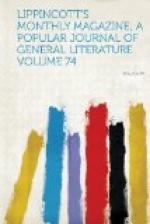objects much removed. We see the summits of hills,
each having its name, as St. Leonard’s, Cooper’s,
Highstanding,
etc., and glimpses of the river
and of some country-seats. St. Anne’s Hill
was the home of Fox; at St. Leonard’s dwelt
the father of his rival and rival of his father, and
at Binfield, Pope, of whom it is so hard to conceive
as having ever been young, “lisped in numbers,
for the numbers came,” natural descriptions,
ethical reflections,
vers de societe and all,
for around him here there was food for them all.
To descend from Pope in point of both time and romance,
the view includes the scenes of Prince Albert’s
agricultural experiments. Quite successful many
of them were. He was a thoroughly practical man—a
circumstance which carried him by several routes across
ploughed fields and through well-built streets, straight
to the hearts of the English people. His memory
is more warmly cherished, and impressed upon the stranger
by more monuments, than that of any other of the German
strain. It might have been less so had he succeeded
in the efforts he is now known to have made soon after
his marriage to attain a higher nominal rank.
He possessed, through the alliance of Leopold and
Stockmar and the devotion of Victoria, kingly power
without the name and the responsibility, and with
that he became content. He used it cautiously
and well when he employed it at all. His position
was a trying one, but he steered well through its
difficulties, and died as generally trusted as he
was at first universally watched. The love-match
of 1840 was every way a success.
[Illustration: EAST FRONT, WINDSOR CASTLE.]
Another figure, more rugged and less majestic, but
not less respectable, will be associated with Victoria
in the memories, if not the history proper, of her
reign. This is John Brown, the canny and impassive
Scot, content, like the Rohans, to be neither prince
nor king, and, prouder than they, satisfied honestly
to discharge the office of a flunkey without the very
smallest trace of the flunkey spirit. He too
has lived down envy and all uncharitableness.
Contemptuous and serene amid the hootings of the mob
and the squibs of the newspapers, he carries, as he
has done for years, Her Majesty’s shawl and
capacious India-rubbers, attends her tramps through
the Highlands and the Home Park, engineers her special
trains and looks after her personal comfort even to
the extent of ordering her to wear “mair claes”
in a Scotch mist. The queen has embalmed him in
her books, and he will rank among the heroes of royal
authors as his namesake and countryman the Cameronian,
by favor of very similar moral qualities, does with
those of more democratic proclivities.
[Illustration: QUEEN ELIZABETH’S BUILDING,
WINDSOR.]
We cannot apply literally to the view from Windsor
Thackeray’s lines on “the castle towers
of Bareacres:”
I stood upon the donjon keep and viewed
the country o’er;
I saw the lands of Bareacres for fifty
miles or more.




